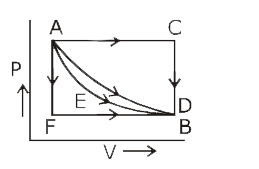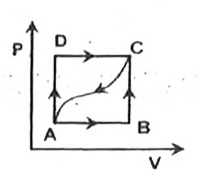50 eal of heat should be supplied to take a system from the state A to the state B through the path ABC as shown in ,find the quantity of heat to be supplied to take it from A to B via ADB.

The correct Answer is:A, C
In path ACB,ΔQ=50cal.=(50×4⋅2)J
=210J,<br>DeltaW=W_(AC)+W_(CB<br>=50×10−3×200×10−6
=10Jltbrge10J<br>DeltaQ=DeltaU+DeltaW<br>⇒ΔU=ΔQ−ΔQ−Δ−ΔW=(210−10)J<br>200J<br>InpathADB,ΔQ=?<br>ΔU=200J<br>(Internale≠rgychan≥betweentwop∮isalwayssame)
ΔW=W(AD)+W(DB)=ΔW<br≥0+155×103×200×10−6
=31J
ΔQ=ΔU+δW
=(200+31)J=231J
= 55cal.

Topper's Solved these Questions
- LAWS OF THERMODYNAMICSBOOK - HC VERMACHAPTER - LAWS OF THERMODYNAMICSEXERCISE - Short Answer
15 Videos
- LAWS OF THERMODYNAMICSBOOK - HC VERMACHAPTER - LAWS OF THERMODYNAMICSEXERCISE - Objective 2
5 Videos
- KINETIC THEORY OF GASESBOOK - HC VERMACHAPTER - KINETIC THEORY OF GASESEXERCISE - Exercises
62 Videos
- NEWTON'S LAWS OF MOTIONBOOK - HC VERMACHAPTER - NEWTON'S LAWS OF MOTIONEXERCISE - Exercises
42 Videos
Similar Questions

50 cal of heat should be supplied to take a system from the state A to the state B through the path ACB as shown in Figure. The quantity of heat to be supplied to take it from A to B via ADB.
View SolutionThe given figure shown a change of state A to state C by two paths ABC and AC for an ideal gas. Calculate the :

(a) Path along which work done is least.
(b) Internal energy at C if the internal energy of gas at A is 10J and amount of heat supplied to change its state to C through the path AC is 200J.
(c) Amount of heat supplied ot the gas to go from A to B, if internal energy of gas at state B is 10J.
View Solution
Knowledge Check
An ideal gas undergoes change in its state from the initial state I to the final state F via two possible paths as shown. Then
 Athere is no change in internal energy along path 1Bheat is not absorbed by the gas in both pathsCthe temperature of the gas first increases and then decreases for path 2Dwork done by the gas is larger in path 1.
Athere is no change in internal energy along path 1Bheat is not absorbed by the gas in both pathsCthe temperature of the gas first increases and then decreases for path 2Dwork done by the gas is larger in path 1.An ideal system can be brought from stage A to B through Four paths as shown in the figure. The energy given to the system is minimum is:
 Apath ACBBpath ADBCpath AEBDpath AFB
Apath ACBBpath ADBCpath AEBDpath AFB
The given figure shows a change of state A to state C by two paths. ABC and AC for an ideal gas. Calculate the ,

(a) Path along which work done is least.
(b) Internal energy at C if the internal energy of gas at A is 10 J and amount of heat supplied to change its state to C through the path AC is 200 J.
( c) Amount of heat supplied to the gas to gd from A to B, if internal energy of gas at state B is 10 J.
(ii) In an insulated contained 1 mole of a liquid, molar volume 100 mL. is at 1 bar liquid is steeply taken to 100 bar, where volume of liquid decreases by 1 mL. Find ΔE and ΔH for the process?
(iii) 14 g of oxygen at 0∘ C and 10 atm are subjected to reversible adiabatic expansion to a pressure of 1 atm. Calculate the work done in
(i) Litre atm.
(ii) Calorie (Given, CpCv=1.4).
View SolutionAn ideal system can be brought from stage A to B through four paths as shown in the figure. The heat energy given to the system is minimum in :

View Solutionshows three paths through which a gas can be taken from the state A to the state B. calculate the work done by the gas in each of the three paths.


View SolutionIn the adjoinign P-V diagram, 100 J of heat is given in taking a system from A to C along the path ADC and 50 J of work is done by system in this path.
a. If the work done by the suystem is 15 J along the path ABC, then how much heat is to be given in taking the system from A to C along ABC?

b. How much heat will be absorbed or given out if the work done on the system along the curved path from CA to A is 15 J?
c. If UB−UA=40J, then how much heat will be absorbed in each process AB and BC?
View SolutionFigure shows three paths through which a gas can be taken from the state A to the state B. Calculate the work done by the gas in each of the three paths.

View SolutionIn the given figure, an ideal gas changes it state from A to state C by two paths ABC and AC.
(i) Find the path along which work done is the least.
(ii) The internal energy of the gas at A to 10J and the amount of heat supplied to change its state to C through the path AC is 200J. Calculate the internal energy at C.
(iii) The internal energy of the gas at state B is 30J. Find the amount of heat supplied to the gas to go from A→B.

View Solution
